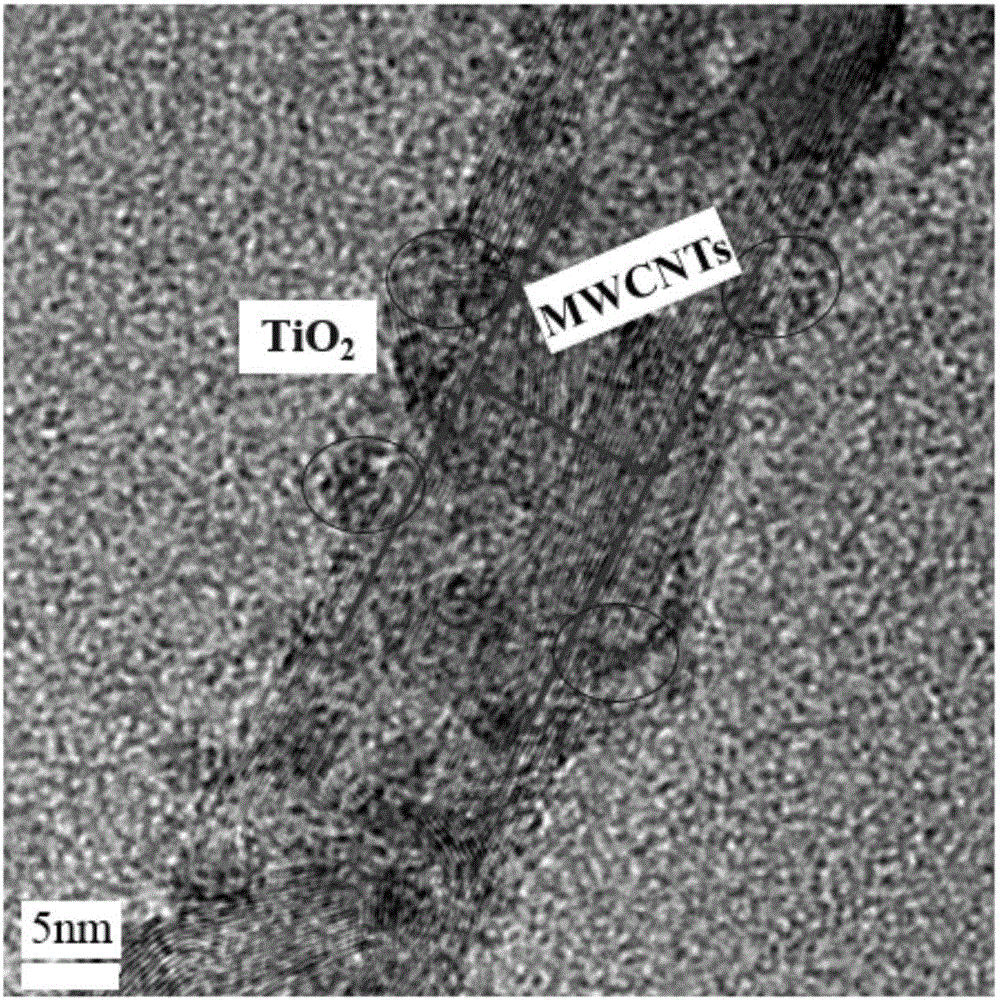Microcystic toxin molecular imprinting functionalization TiO2@CNTs photoelectric sensor electrode and photoelectric analysis method with same
A technology of microcystin and molecular imprinting, applied in nanotechnology for materials and surface science, material electrochemical variables, nanotechnology, etc., can solve problems such as poor stability and easy degradation of polymer molecular imprinting, and achieve Rapid response, good application prospects, excellent selective recognition effect
- Summary
- Abstract
- Description
- Claims
- Application Information
AI Technical Summary
Problems solved by technology
Method used
Image
Examples
Embodiment 1
[0050] A microcystin molecularly imprinted functionalized TiO 2 @CNTs photoelectric sensing electrode consists of a base electrode and MI-TiO covered on the surface of the base electrode 2 @CNTs nanomaterial composition, the MI-TiO 2 @CNTs nanomaterials consist of multi-walled carbon nanotubes and TiO wrapped on the outer surface of multi-walled carbon nanotubes 2 Nanoparticle layer and TiO 2 The surface of the nanoparticle layer is modified by MC-LR in situ molecular imprinting sites, and the base electrode is an FTO electrode. The electrode is obtained through the following steps:
[0051] (1) Pretreatment of multi-walled carbon nanotubes: weigh about 0.1g MWCNTs in 3M HNO 3 The solution was placed in a round-bottomed flask, condensed and refluxed in an oil bath at 110°C for 8 hours, and MWCNTs precipitated at the bottom of the round-bottomed flask at the end. After taking it out, wash it with distilled water until neutral. During the process, use a high-speed centrifug...
Embodiment 2
[0060] Adopt the MI-TiO that embodiment 1 prepares 2@CNTs / FTO sensing electrodes for photoelectrochemical detection of MC-LR.
[0061] Using the traditional three-electrode system to prepare MI-TiO 2 @CNTs / FTO is the working electrode, the saturated calomel electrode is the reference electrode, and the platinum wire electrode is the counter electrode, with 0.1mol / L Na 2 SO 4 The buffer solution is a supporting electrolyte solution. A series of MC-LR standard solutions with different concentrations were gradually added to the system by the standard addition method (every time the MC-LR standard solution was added to the supporting dielectric solution, it was diluted 1000 times). , apply a bias voltage of 0.6V, and use the I-t curve method to measure the photocurrent of the MC-LR system with different concentrations under full-wave light excitation, and convert it into photocurrent density (j) according to the working area of the electrode. Through the analysis results, it...
Embodiment 3
[0063] Adopt the MI-TiO that embodiment 1 prepares 2 @CNTs / FTO sensing electrodes for selective performance detection.
[0064] MI-TiO prepared by 2 @CNTs / FTO is the working electrode, the saturated calomel electrode is the reference electrode, and the platinum wire electrode is the counter electrode, with 0.1mol / L Na 2 SO 4 The buffer solution is a supporting electrolyte solution. Apply 0.6V bias voltage, adopt I-t curve method to measure the photocurrent of the mixed system containing 0.1nM MC-LR solution and 100 times molar concentration of interfering substances in MC-LR respectively under full-wave light excitation, and calculate the relative photocurrent ratio (R ), to obtain the selectivity of the sensor. Interfering substances include monosultap, paraquat, omethoate, acetamiprid, atrazine, glyphosate or humic acid. The results showed that when containing monosultap, paraquat, omethoate, acetamiprid, atrazine and glyphosate at 100 times the molar concentration of M...
PUM
 Login to View More
Login to View More Abstract
Description
Claims
Application Information
 Login to View More
Login to View More - R&D
- Intellectual Property
- Life Sciences
- Materials
- Tech Scout
- Unparalleled Data Quality
- Higher Quality Content
- 60% Fewer Hallucinations
Browse by: Latest US Patents, China's latest patents, Technical Efficacy Thesaurus, Application Domain, Technology Topic, Popular Technical Reports.
© 2025 PatSnap. All rights reserved.Legal|Privacy policy|Modern Slavery Act Transparency Statement|Sitemap|About US| Contact US: help@patsnap.com

